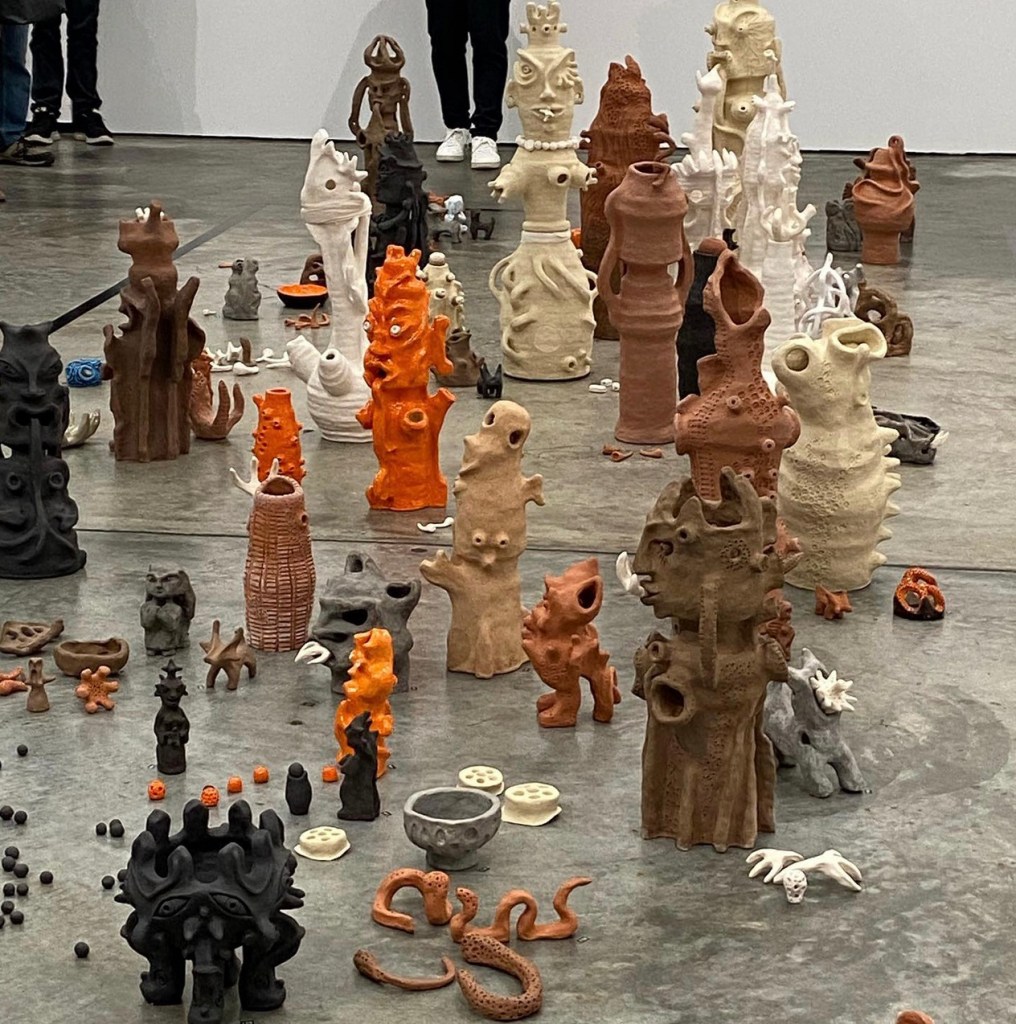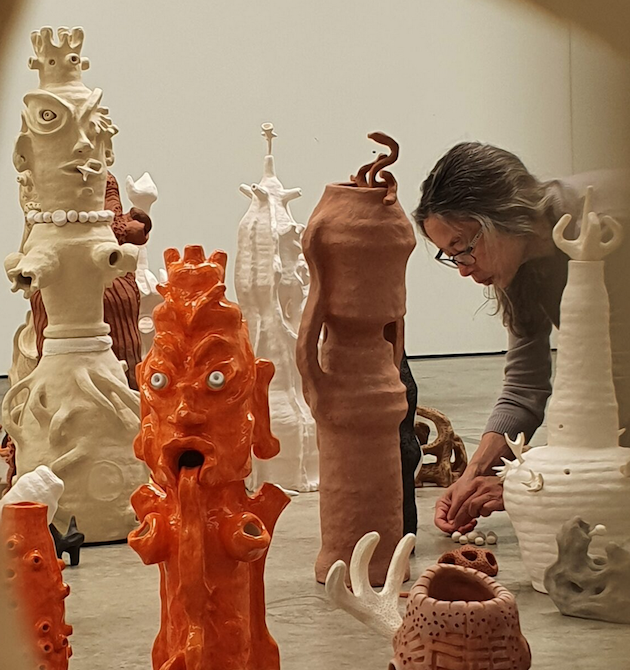The Berlin Biennale is one of those edgy events on the European art calendar that always throws up something new; it pushes against the expected and can offer pathways forward in a career.
What comes to mind, as example, is the trajectory of Japanese artist Chiharu Shiota – who studied in Canberra before showing at the Berlin Biennale where Mami Kataoka (Director, Mori Art Museum, Tokyo) saw her work. Despite being Japanese, Shiota had totally been off her radar until then, and it launched her international career.
Shiota’s survey exhibition has just been shown at Queensland Art Gallery / Gallery of Modern Art, and has toured globally.
Mai Nguyen-Long is currently showing her Vomit Girl (Berlin Cluster) at the 12th Berlin Biennale, along with two earlier series, reconsidered and remade. It represents the next turning point in her career.
While Nguyen-Long’s Berlin representation has largely slipped softly under the radar here in Australia (until now) – partly due to the Biennale announcing artists only the week prior to the exhibition opening – her current exhibition at Art Atrium in Sydney is a moment to pause, absorb and celebrate.
Nguyen-Long also studied in Canberra (like Shiota), and her 30-year career has navigated her conflicted relationship with her Vietnamese heritage.
Titled Diasporic Dialogue, Nguyen-Long shares the gallery space with photographer William Yang – another artist who has used his artwork as a platform to explore and reconcile his Chinese Australian identity.
Clearly the thread here is that diasporic connection, but it goes deeper for this pair. At a point when Nguyen-Long was struggling with the framing placed upon her ‘cultural place’ here in Australia as an artist of Vietnamese heritage (one that always felt like an imposed framing), she met Yang. Around the same time she burnt an effigy – a sculpture from her Mongrel Dog series (2009) – at Casula Powerhouse as a cathartic flip-point to that ‘contested legitimacy’, which has caused her so much trauma.
What is interesting about this pairing of works at Art Atrium – apart from Yang’s photographs offering a nice counterpoint to Nguyen-Long’s earthy sculptures – is that they have both harnessed that trauma and driven forward, owning their creative expression.

So walking into to Art Atrium’s Botany space (on a very wet weekend), that back history seemingly settled into a clean and coherent hang, celebrating the vibrancy and eddies in each of these artist’s works. That confidence and ease is clear in these mature career works.
Yang’s presentation is an extremely abridged version of his QAGOMA survey exhibition Seeing and Being Seen, and never disappoints. For this writer, it is the text handwritten on the surface of his photographs that hold that thread of humanity, and connection as a storyteller.
Nguyen-Long’s sculptures sits across the gallery floor – a kind of flotilla of ceramic totems corralled within a formal field. It is an installation that compliments her work in Berlin – both drawn from the same series, and her doctoral works (2022).
She made the shift to working with clay after a decade of using papier mache, a reintroduction to Vietnamese đình wood carvings as a trigger. Nguyen-Long says of the shift – which occurred after her 2014 Beyogmos solo exhibition at Wollongong Art Gallery (WAG): ‘I recognised that my entire artistic practice stemmed from this uncertain relationship with Vietnam.’
Read: Exhibition review: Riggs & Miller, PS Art Space
A self-organised residency saw her staying in Bát Tràng ceramics village in 2015. It was a light switch moment. She told New Mandala blog: ‘Ceramic’s reputation as a lowly material strengthened my resolve to use clay to draw out unofficial stories and histories, and relinking with narratives of the đình.’
Nguyen-Long continues: ‘In 1994 I studied and wrote about them [đình wood carvings] in the Vietnamese language I had just acquired as part of a self-imposed language learning regime – as I was never taught Vietnamese at home.
‘The hopeful relationship that I developed with Vietnam in 1994 was challenged when I returned to Australia unwittingly speaking Vietnamese with a northern “communist” accent. I responded extremely by “deleting” my experiences in Vietnam,’ Nguyen-Long tells Elly Kent (New Mandala).
It is a story so familiar to many Asian-Australians, including Yang.
Nguyen-Long largely put that ‘connection’ aside for two decades, compartmentalising her identity as we so often do in Australia. But ‘re-finding’ these carving traditions liberated her work from the war rhetoric and politics that has pushed against her making in Australia.

What emerged was Vomit Girl – a kind of vomiting totemic goddess form, whose tongue-like fluid gesture stands in for the loss of ‘mother tongue’ and language.
It first started as a pen drawing on a notepad in 2014, (Nguyen-Long incessantly draws as a kind of cathartic stream of conscious against deep seated trauma), and has risen into this powerful totem – almost like a phoenix from ashes.
Concurrently, Nguyen-Long is a finalist in Woollahra Small Sculpture Prize – which also opened this week – with a Vigit / Vomit Girl work.
Whether it is a totemic form or drawing practice – this quasi alter ego / connective cultural tissues – is about finding that grounding quality through clay. Nguyen-Long started working with clay 20-years into her practice, and describes it as a kind of ‘spiritual resistance’.
We start to come to see this flotilla of forms caught between animal and human, abstraction and figurations, generic and worldly, yet idiosyncratic and fiercely individual, as a pathway for many who struggle with diasporic badges.
While some emphasis has been placed on Nguyen-Long’s surfacing and glazes of her clay sculptures – aka raw and brutal or acid toxic orange to trigger references to Agent Orange and also Buddhist monk robes – we, as viewers, start to allow ourselves to slip beyond initial impressions and allow intrigue to percolate our own questions to the surface.
Uncomfortable questions and difficult art is easier to dismiss or walk away from; it is interesting that it took a celebration in Berlin and the world’s art press for Nguyen-Long’s work to start to be ‘looked’ at more seriously here.
Nguyen-Long’s closing words are so inspiring: ‘My desire to build objects to replace erased memories, generate new stories, transform destructive energies, and provide talismanic protection could never be ephemeral.’
A nod needs to be given also to Simon Chan, who for decades has been a champion of artists taking the tougher routes, and wanting to explore those bridges – that Diasporic Dialogue.
Nguyen-Long’s Doctoral paper, Vomit Girl Beyond Diasporic Trauma: Interconnecting Contemporary Art and Folkloric Practices in Vietnam (2022), my guess is it will be a point of reference for many artists moving forward, searching for their own voice in a diasporic landscape.
Diasporic Dialogue: Mai Nguyen-Long and William Yang is showing at Art Atrium in Sydney from 8 – 22 October.
Ngyuen-Long’s work is also in the Woollhara Small Sculpture Prize from 13 October – 20 November.





